Stabilization of Expansive Soil Using Industrial Waste: Fly Ash- Juniper Publishers
Juniper Publishers- Journal of Civil Engineering
Abstract
An experimental investigation is carried out to study
the stabilization of locally available expansive soils using fly ash
(industrial waste) and lime. Initially fly ash is added to the expansive
soils in proportions of ranging from 5% to 30% by weight of dry soils
with an increment of 5% and then the geotechnical characteristics such
as consistency, swelling, compaction, California bearing ratio (CBR) and
consolidation characteristics of stabilized soil are studied. The ideal
soil-fly ash mixture with better results is found as soil (70%): fly
ash (30%). Then lime is added at low percentages i.e., 1% to 5% to the
ideal soil-fly ash mixed sample. The soil-fly ash-lime mixed samples are
also tested in the laboratory to determine their above geo-technical
properties. For soaked CBR, the soil-fly ash-lime mixed samples are
soaked in water for the periods of 4,
7, 14, 21, 28 and 56 days. From the experiment it is revealed that the
expansive soils mixed with 30% fly ash and 4% lime gained the maximum
CBR value.
Keywords: California bearing ratio; Consolidation; Expansive; Fly ash; Free swell index; Stabilization
Abbreviations: Ground
Granulated Blast-Furnace Slag (GGBS), California Bearing Ratio (CBR),
Free Swell Index (FSI), Optimum Moisture Content (OMC), Maximum Dry
Density (MDD)
Introduction
On wetting, the expansive soil undergoes swelling,
resulting in loss of its strength. Further, the expansive soil undergoes
shrinking on drying leading to the development of shrinkage cracks. The
swell-shrink characteristics of the expansive soil causes the
differential movements resulting in severe damage to the foundations,
buildings, roads, retaining structures, canal
linings, etc. Basically in India, this expansive soil is commonly
known as black cotton soil and it covers about 20% of the total land
area and extends over number of states including Odisha [1].
So, it has always been a great challenge for geo- technical engineers
to improve the characteristics of expansive soil through various
innovative and cost effective techniques.
Stabilization is one of the techniques among them to improve
the geo- technical properties of the expansive soil. Stabilization can
be achieved by using different additives. The industrial wastes such as
fly ash, dolochar, ground granulated blastfurnace slag (GGBS), lime kiln
dust, cement kiln dust, etc are generated from various industries in
the state of Odisha. The industries generally dump the industrial wastes
in their vicinity causing environmental hazards. Hence, there is an
urgent need to explore and exploit the use of the above industrial
wastes for minimizing the environmental hazards.
Much research has been done on the fly ash and it has
been concluded that fly ash can be a good additive with lime to enhance
the engineering properties of expansive soil. JM Kate [2] studied the behaviour of expansive soil treated with lime and fly ash. Sahoo et al. [3]
studied the strength characteristics of fly ash mixed with lime
stabilized soil. They revealed that the 15% fly ash mixed with 4% lime
of the dry weight of soil achieved maximum strength. Recep et al. [4]
studied the swelling and strength characteristics of high plastic clay
treated with lime and gypsum. They concluded that at 6% lime, the
swelling characteristics decreased to 99.55%, swelling pressure
decreased to 98.98% and unconfined compressive strength increased to
191.87% at prolong curing. Mohanty et al. studied the stabilization of
expansive soil by using fly ash and dolochar.
Similarly, many other researchers like Cocka [5-15],
Etim et al. and many others have studied the improvement of various
engineering properties of expansive soil with addition of fly ash and
lime.
From the review of literature, it is observed that no
research work has been done so far in stabilization of the expansive
soil of eastern India (state of Odisha) using the local industrial
wastes as additives. Hence, in this research an attempt has been made to
study the behaviour of locally available expansive soils by using fly
ash and lime. This paper reveals that the strength characteristics of
locally expansive soil can be increased with the addition of different
percentage of fly ash and lime which shown that expansive soil can
satisfactorily be used mixed with fly ash and lime for construction of
road, pavements, foundation, etc.
Materials Used
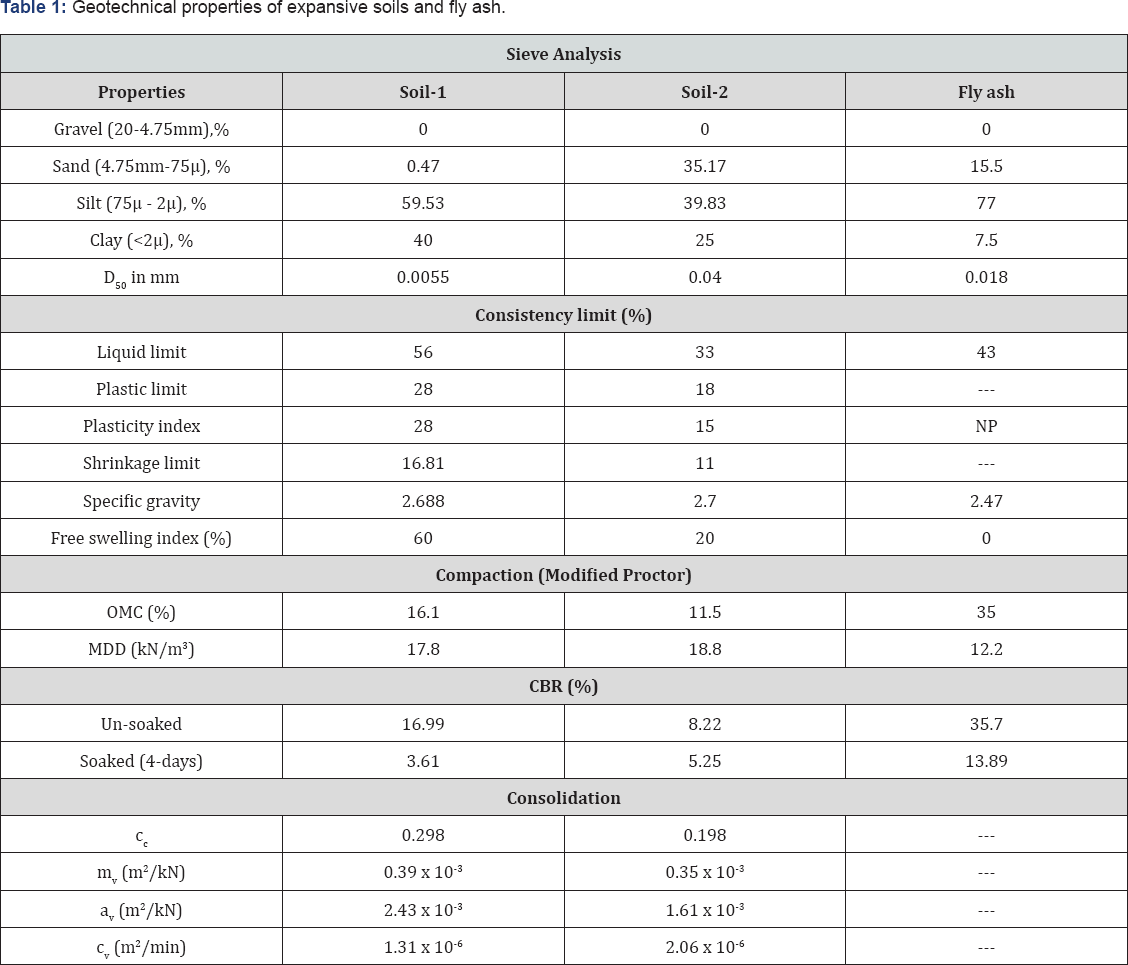
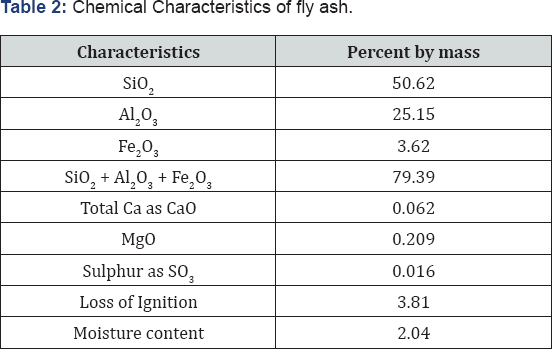
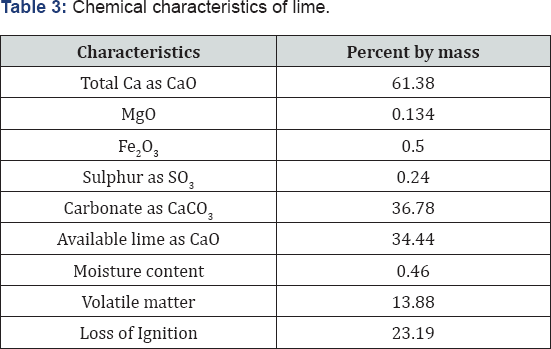
In the present research, two types of local expansive
soils are used. One is high expansive soil (soil-1) collected from the
Balasore, India and other is low expansive soil (soil-2) collected from
the Bhubaneswar, India. The industrial waste i.e., fly ash is collected
from the local industry (Birla Tyres Ltd., Balasore, India) and the
quick lime is collected from the local market From the laboratory test,
the high expansive soil is classified as highly compressible clay (CH),
whereas the low expansive soil is classified as low compressible clay
(CL). The fly ash used in the experiment is classified as Class F fly
ash. The geo-technical properties of soil-1, soil-2 and fly ash are
reported in details in Table 1. The chemical analysis of fly ash and lime are presented in Table 2,3 respectively.
Experimental Programme
The virgin materials such as expansive soils, fly ash
and lime are kept in hot air oven at 105 °C to dry completely. Then dry
soil samples are broken in to small pieces and sieved through 4.75mm IS
sieve. The materials which passed through the 4.75mm IS sieve are used
for the preparation of soil-fly ash and soil-fly ash -lime samples.
Firstly fly ash is added to the expansive soils from 5% to 30% by dry
weight of mixed samples with an increment of 5%. Total 12 nos. of
soil-fly ash mixed samples is prepared. Then the soil-fly ash mixed
Samples are tested in the laboratory to determine their consistency,
swelling, compaction, California bearing ratio (CBR) and consolidation
characteristics. From the test results, an ideal soil-fly ash mixture
with better results is found as soil (70%): fly ash (30%). Then the lime
in dry powder form is added to the soil (70%): fly ash (30%) at
different percentages, starting from 1% to 5% by dry weight of soil-fly
ash mix sample. In this way total 10 nos. of soil-fly ash- lime mixed
samples are prepared. The soaked CBR of soil-fly ash samples are
determined by soaking the samples in water for 4 days, whereas the
soaked CBR of soil-fly ash-lime samples are determined at the soaking
periods of 4, 7, 14, 21, 28 and 56 day in water.
Results and Discussion
The geo-technical properties such as consistency,
swelling, compaction (OMC and MDD), strength (CBR) and consolidation
characteristics of stabilized samples viz, soil-fly ash and soil-fly
ash-lime are studied by conducting successive laboratory tests.
Consistency Characteristics
The consistency characteristics of stabilized samples
are studied by conducting liquid limit and plastic limit test. It is
noticed that the liquid limit and plasticity index of soil-fly ash
samples decreased with the increase of fly ash content, whereas the
plastic limit of soil-fly ash samples increased with the increase of fly
ash content. The decrease of liquid limit may be partly due to the
flocculation of soil particles resulting from the cation exchange
between the cations contained in the fly ash and the readily
exchangeable cations on the soil particle. The increase in silt and sand
fractions might have caused the decrease in the soil specific surface
area and consequently its water affinity. The consistency limits of
soil-fly ash show maximum variation at 30% fly ash content. Then the
addition of lime into the soil (70%)-fly ash (30%) samples, the liquid
limit, plastic limit and plasticity index decreased. The liquid limit,
plastic limit and plasticity index of soil-fly ash-lime samples
decreased with the increase of lime content.
Swelling Characteristics
With addition of fly ash to the expansive soils, the
free swell index (FSI) of soil-fly ash samples gradually decreased with
the increase in fly ash content Figure 1.
At 30% fly ash Stabilization of Expansive Soil Using Industrial Waste:
Fly Ash content, the FSI of soil-1 of soil-2 is decreased by 86% and
100% as compared to their virgin state. When lime is added to the soil
(70%)-fly ash (30%) sample, the FSI gradually decreased with the
increase of lime content. Figure 2 shows the variation of FSI of soil-fly ash- lime mixed samples.
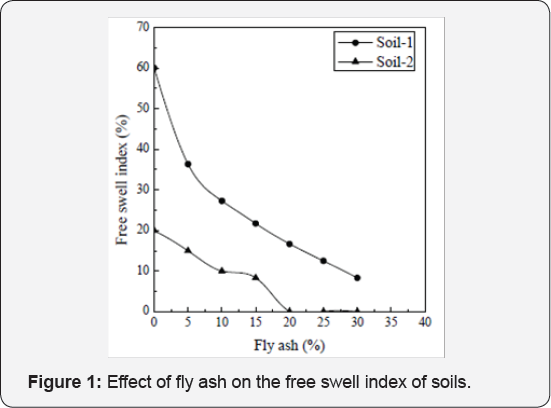

Compaction Characteristics
A series of compaction tests are conducted on the
soil-fly ash mixed samples. From the test result it is seen that the
optimum moisture content (OMC) and maximum dry density (MDD) of soil-
fly ash mixed samples are increased and decreased respectively with the
increase of fly ash content. The variation of OMC and MDD of soil-fly
ash may be due to the following reasons.
o The decrease in MDD with increase in fly ash
content is associated with the notion that fly ash is light weight
because of its low specific gravity compared to the soils.
o The higher OMC associated with the higher fly ash content as the hydration reaction for cementitious fly ash requires water.
When lime is added to the soil (70%)-fly ash (30%)
sample, the OMC and MDD of stabilized samples gradually increased with
the increase of lime content. This may be due to the gradually
increasing of specific gravity of stabilized soil (soil-fly ash-lime
mix) with the increasing of lime content.
Strength Characteristic
California bearing ratio
The un-soaked and soaked (4 days soaking) CBR of soil-fly ash mixed samples increased with the increase of fly ash content. Figure 3
shows the effects of fly ash on the 4 days soaked CBR of soil samples.
The increase in CBR by the addition of fly ash may be due to the
following;
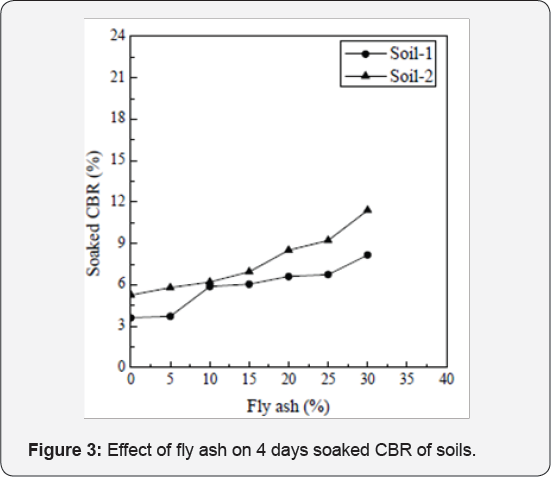
o Flocculation and agglomeration of clay particle
take place by the cation exchange reaction in soil-fly ash, resulting
granular particles.
o Formation of granular particles increases with the
increase of fly ash content At 30% fly ash content, the 4 days soaked
CBR of soil-1 and soil-2 increased by 126% and 117% respectively as
compared to soil alone.
Figure 4,5
show the effect of lime on CBR of soil-fly ash-lime samples of soil-1
and soil-2 respectively at different soaking periods. It is observed
that the soaked CBR of soil-fly ash-lime samples are increased with the
increase of lime content. It is also noticed that for a given lime
content, the soaked CBR of soil-fly ash-lime sample is increased with
the increase of soaking period in water. The increase in CBR in presence
of lime after prolonged period of soaking may be due the following
reasons.

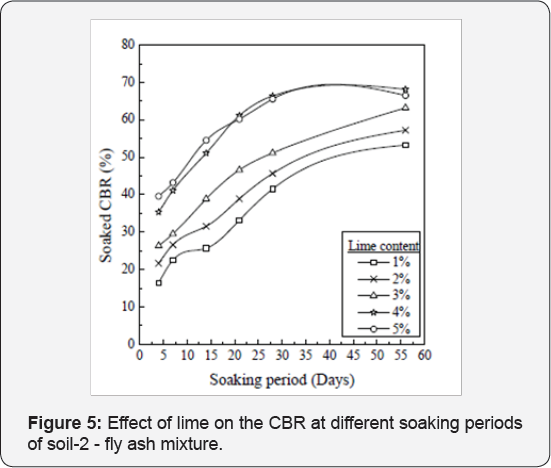
o Pozzolanic reaction in the mixture is favoured due
to soaking whereby granular particles are formed due to the presence of
fly ash.
o Addition of lime causes the pozzolanic reaction
between silica and alumina present in soils and fly ash in the mixed
samples under prolonged soaking. The cementing action increases with the
increase of lime content in the soil- fly ash-lime mixed sample. The
CBR values increased with the increase of lime content. However, after
4% lime content there is no appreciable increase in CBR.
In the present study, the 4 days soaked CBR of soil-1
increased from 3.61 to 29.74% (increased by 724%) by the addition of
30% fly ash and 4% lime, whereas the 4 days soaked CBR of soil- 2
increased from 5.25 to 35.33% (increased by 573%) by the addition of
same percentage of fly ash and lime.
Consolidation Characteristics
The consolidation characteristics of soil-1 and
soil-2 with the addition of fly ash at different percentages are studied
by conducting a series of consolidation tests. The compression index
(cc), co-efficient of volume change (mv) and co-efficient of
compressibility (av) of soil- fly ash mixed samples are decreased with
the increase in fly ash content, whereas the co-efficient of
consolidation (cv) of soil-fly ash samples increased with the increase
of fly ash content. The cause of decrease in the above consolidation
parameters may be due to the increase in the flocculation and
aggregation caused by the addition of fly ash resulting induced
pre-consolidation effect, which increases the vertical effective yield
stress and reduces the compressibility characteristics. Figure 6 shows the effect of fly ash on the compression index of soils.
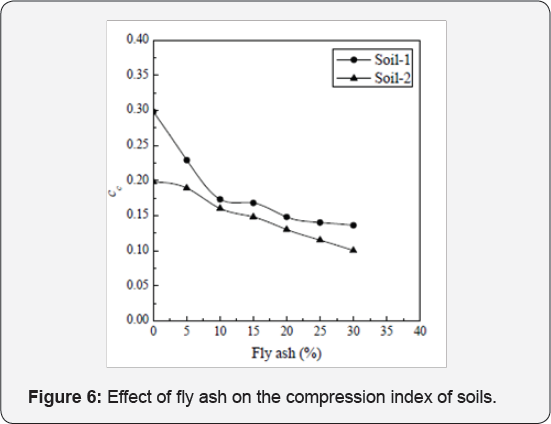
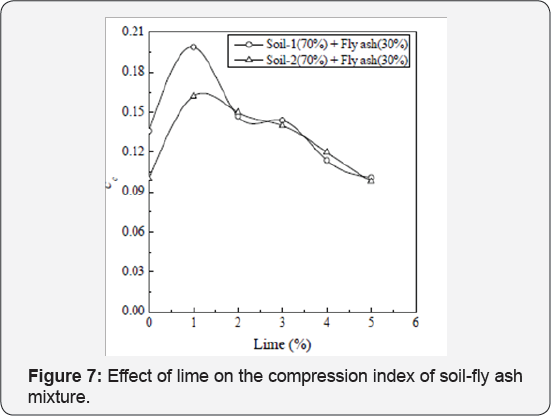
Again, when lime is added to the soil (70%)-fly ash
(30%) samples, the compression index (cc), co-efficient of volume change
(mv), co-efficient of compressibility (a v) and coefficient of
consolidation (cv) of soil-fly ash-lime mixed samples are decreased with
the increase in lime content. The decrease of compressibility
characteristics of the mixture may be due to the agglomeration
formations of soils treated with fly ash and lime, which results in
stronger lime particle agglomerates giving higher resistance to
compression. Figure 7 shows the effect of lime on the compression index of soil-fly ash samples.
Conclusion
The effect of fly ash and lime on the geo-technical
properties of local expansive soils is thoroughly investigated. Based on
the results of experimental investigation the following conclusions are
drawn.
o With the addition of fly ash, the L.L. and P.I. of
soils gradually decreased with the increase of fly ash contents. Maximum
decrease is being observed at 30% fly ash content. Also, the addition
of lime to the soil-fly ash mixture reduced the L.L. and P.I. further.
o Addition of fly ash decreased the FSI of soils,
maximum Decrease is being observed at fly ash content of 30%.
Stabilization of Expansive Soil Using Industrial Waste: Fly Ash Addition
of lime to the above mixture reduced the FSI further. The FSI of soil-1
and soil-2 with 30% fly ash and 4% lime content are reduced by 100%.
o The OMC and MDD of soil-fly ash mixed samples are
increased and decreased respectively with the increase of fly ash
content. However, with the addition of lime in to the soil (70%)-fly ash
(30%) mixed samples, the OMC and MDD gradually increased with the
increase of lime content.
o CBR of soil-fly ash mixed samples is increased with
the increase of fly ash content. The maximum increase is being observed
at 30% fly ash content. At 30% fly ash content, the 4 days soaked CBR
of soil-1 and soil-2 is increased by 126% and 117% respectively. Again
the soaked CBR of stabilized soils with 30% fly ash increased further
with increase in lime content, the maximum increase is being observed at
4% lime content. Also, for a given lime content, the CBR values of
soil-fly ash-lime are increased with the increase of soaking periods.
With 30% fly ash and 4% lime content, the 4-days soaked CBR of soil-1
and soil-2 increase by 724% and 573% respectively as compared to parent
soils.
o With the increase of fly ash content, the
compression index (cc), co-efficient of volume change (mv) and
co-efficient of compressibility (av) of the mixture soils decreased and
co-efficient of consolidation (cv) increased. With addition of lime all
the above parameters decreased.
o The optimum mixture design proportion of soil-fly
ash- lime is found to be 70:30:04 for the materials i.e., soils, fly
ash, dolochar, lime, etc taken for the studies in this case.
o Stabilization by addition of fly ash with or without lime is found to be more effective in case of highly expansive soil.
o Addition of 30% fly ash with 4% lime will
definitely improve the local expansive soil for sustainable use in the
construction of roads, pavements and foundations which will reduce the
cost of construction and disposal problem of industrial wastes which
otherwise lead to environmental hazards.
For More Open Access Journals Please Click on: Juniper Publishers
Fore More Articles Please Visit: Civil Engineering Research Journal
Fore More Articles Please Visit: Civil Engineering Research Journal


Comments
Post a Comment